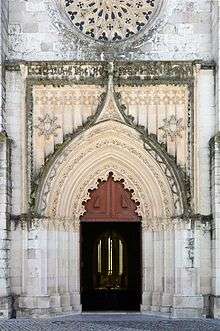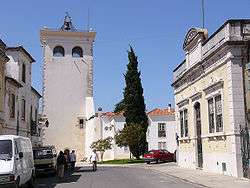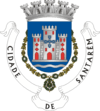Santarém, Portugal
| Santarém | |||
|---|---|---|---|
| Municipality | |||
|
Cabaças tower, formerly part of the city's fortifications. | |||
| |||
 | |||
| Coordinates: 39°14′N 08°41′W / 39.233°N 8.683°WCoordinates: 39°14′N 08°41′W / 39.233°N 8.683°W | |||
| Country |
| ||
| Region | Ribatejo | ||
| Subregion | Lezíria do Tejo | ||
| Intermunic. comm. | Lezíria do Tejo | ||
| District | Santarém | ||
| Parishes | 18 | ||
| Government | |||
| • President | Ricardo Gonçalves (PSD) | ||
| Area | |||
| • Total | 552.54 km2 (213.34 sq mi) | ||
| Population (2011) | |||
| • Total | 61,752 | ||
| • Density | 110/km2 (290/sq mi) | ||
| Time zone | WET/WEST (UTC+0/+1) | ||
| Website | http://www.cm-santarem.pt | ||
Santarém (Portuguese pronunciation: [sɐ̃tɐˈɾɐ̃j]) is a city and municipality located in the district of Santarém in Portugal. The population in 2011 was 61,752,[1][2] in an area of 552.54 km².[2][3] The population of the city proper was 29,929 in 2012.
The Mayor is Ricardo Gonçalves (PSD). The municipal holiday is March 19, day of São José.
History


Since prehistory, the region of Santarém has been inhabited, first by the Lusitani people, and then by the Greeks, Romans, Visigoths, Moors and later Portuguese Christians. Of the various legends related to the foundation of Santarém, the most famous tells of the Visigoth Saint Iria (or Irene), who was martyred in Tomar (Nabantia) and whose uncorrupted body reached Santarém. In her honour, the name of the town (then known by its Latin name Scalabis) would later be changed to Sancta Irene, from which Santarém would eventually be derived.
The foundation of the city is attributed to the Romans, who occupied the region in the 2nd century BC and named the city Scalabis. During the Roman period, Scalabis was an important commercial post in the mid-Tagus region, and was the administrative capital of one of the regions (Conventus Escalabitanus) of Lusitania. Julius Caesar creates in 61 a.c., a military camp in Santarém. The city takes at this time the designation of Scallabis Praesidium Iulium.
The III century crisis and the decline of the Western Roman Empire affected the civitas, and in the V century the town was conquered by the barbarians(vandals and alans). In 460, the Visigoths, led by Sunerico, gain the city and expelled the alans.[4]
After the period of Visigoth domination, Santarém was taken in the 8th century by the Arabs, under whose rule the city became an important cultural centre. Important Arab personalities born in Santarém (or Shantarin, in Arabic) are the poet and historian Ibn Bassam (died 1147) and the poet Ibn Sara (1043–1123).
The period of Muslim domination was finished in 1147 by the first King of Portugal, Afonso Henriques, who conquered the city on March 15. According to the chronicles, the King and a small army managed to take the city after some men climbed the walls during the night and opened the gates. The story of the conquest of Santarém is told in a heroic tone in the mediaeval chronicle De expugnatione Scalabis, which celebrates and justifies the power of the first Portuguese King. From the military point of view, the conquest of Santarém and, in that same year, of Lisbon were crucial steps in the Reconquista of Portugal.
After the reconquest of the Santarém, the city was frequently visited by the Kings, and many feudal parliaments (Cortes) were held in Santarém. King Fernando I, in particular, was very fond of the city and chose to be buried in the Convent of Saint Francis (his tomb is now in the Carmo Museum in Lisbon). The city was indeed one of the most important in mediaeval Portugal, as attested by its large number of monasteries and its royal palace (now lost where the Cathedral stands). There are still enough examples of Gothic buildings in the city for it to be known as the "Capital of the Portuguese Gothic".
In the 15th century, during the period of Portuguese maritime explorations, expeditions like the conquest of Ceuta (1415) were planned in the royal palace of Santarém. Many important personalities related to this historical time are buried in the churches of Santarém. Pedro de Meneses, first governor of Ceuta (1415–1437) after the Portuguese conquest, is buried in a magnificent Gothic tomb in the Church of the Grace (Igreja da Graça). In the same church is buried Pedro Álvares Cabral, the navigator that discovered Brazil in 1500.
The following centuries represented periods of decadence for Santarém. The big earthquake of 1755 hit the city hard, and many historical monuments were lost. During the Napoleonic invasions (early 19th century) the city was invaded and pillaged.
In the second half of the 19th century many improvements reached Santarém, like canalised water, gas light, the building of a bridge over the Tagus and the railway (1861). In the 20th century the infrastructure of the city (education, housing, commerce) continued to improve, and the economy of the city remained mainly dedicated to the production of agricultural goods.
Geography

The city of Santarém stands is situated on a plateau, located on the right bank of the Tagus River 65 kilometres (40 mi) northeast from Lisbon. This city, the urbanized portion, includes the former-parishes of Marvila, São Nicolau, São Salvador and Várzea, united in the green paper on administrative reform.
Parishes
Administratively, the municipality is divided into 18 civil parishes (freguesias):[5]
- Abitureiras
- Abrã
- Achete, Azoia de Baixo e Póvoa de Santarém
- Alcanede
- Alcanhões
- Almoster
- Amiais de Baixo
- Arneiro das Milhariças
- Azoia de Cima e Tremês
- Casével e Vaqueiros
- Gançaria
- Moçarria
- Pernes
- Póvoa da Isenta
- Romeira e Várzea
- Santarém (Marvila), Santa Iria da Ribeira de Santarém, Santarém (São Salvador) e Santarém (São Nicolau)
- São Vicente do Paul e Vale de Figueira
- Vale de Santarém
Climate
Santarém, Portugal has a Mediterranean climate (Csa).
| Climate data for Santarem | |||||||||||||
|---|---|---|---|---|---|---|---|---|---|---|---|---|---|
| Month | Jan | Feb | Mar | Apr | May | Jun | Jul | Aug | Sep | Oct | Nov | Dec | Year |
| Record high °C (°F) | 20.6 (69.1) |
24.8 (76.6) |
29 (84.2) |
32.2 (89.9) |
36 (96.8) |
43.5 (110.3) |
43 (109.4) |
40.5 (104.9) |
40.2 (104.4) |
33.6 (92.5) |
26.5 (79.7) |
23 (73.4) |
43.5 (110.3) |
| Average high °C (°F) | 14.3 (57.7) |
15.8 (60.4) |
18.4 (65.1) |
19.6 (67.3) |
22.3 (72.1) |
26.7 (80.1) |
30 (86) |
30.2 (86.4) |
28 (82.4) |
22.7 (72.9) |
18 (64.4) |
15 (59) |
21.75 (71.15) |
| Average low °C (°F) | 4.9 (40.8) |
6.2 (43.2) |
7.3 (45.1) |
8.6 (47.5) |
10.6 (51.1) |
13.3 (55.9) |
15.2 (59.4) |
15.3 (59.5) |
14.1 (57.4) |
11.6 (52.9) |
8.4 (47.1) |
6.5 (43.7) |
10.17 (50.3) |
| Record low °C (°F) | −4.4 (24.1) |
−3.5 (25.7) |
−3.5 (25.7) |
0 (32) |
4 (39.2) |
7 (44.6) |
9 (48.2) |
8.5 (47.3) |
7 (44.6) |
−0.5 (31.1) |
−3.7 (25.3) |
−3.2 (26.2) |
−4.4 (24.1) |
| Average precipitation mm (inches) | 91 (3.6) |
79 (3.1) |
51 (2.0) |
66 (2.6) |
56 (2.2) |
23 (0.9) |
8 (0.3) |
5 (0.2) |
36 (1.4) |
84 (3.3) |
91 (3.6) |
104 (4.1) |
696 (27.4) |
| Average precipitation days | 11.9 | 11.6 | 8.9 | 10.8 | 8.8 | 4.6 | 1.7 | 1.7 | 5.1 | 10 | 10.9 | 12.7 | 98.7 |
| Average relative humidity (%) | 87 | 85 | 83 | 77 | 76 | 71 | 67 | 68 | 73 | 80 | 87 | 85 | 78.3 |
| Source: Weatherbase[6] | |||||||||||||
Sister cities
-
 Badajoz, Extremadura, Spain
Badajoz, Extremadura, Spain
Architecture
Santarém has a picturesque city centre with several monuments, including the largest and most varied ensemble of gothic churches in Portugal. These include fine examples of transitional Romanesque–Gothic, mendicant (plain style derived from the mendicant orders) and late (flamboyant) Gothic. In addition, the city has nice examples of Manueline, Renaissance, Mannerist and Baroque architecture.
- Old Castle of Santarém (Porta do Sol): Located on a high slope over the Tagus river and the surrounding landscape, the site of the old castle of Santarém is now a nice garden that offers spectacular views. Part of the walls and towers of the castle are still preserved.
- Church of Saint John of Alporão (Igreja de São João de Alporão): Built between the 12th and the 13th centuries by the Knights Hospitallers, this church is a fine example of transitional architecture, with a Romanesque main portal and an early Gothic main chapel and vaulting. The arches of the ambulatory of the main chapel show Arab (Mudéjar) influences. The church now houses a small Archaeological Museum. Its most important piece is the flamboyant Gothic tomb of Duarte de Meneses, missed in a battle in North Africa in 1465. His magnificent tomb is empty.
- Cabaças Tower (Torre das Cabaças): Ancient defensive tower of the mediaeval wall of the city. Houses the Time Museum with an exhibition about the measurement of time through the ages.
- Fountain of the Fig Tree (Fonte da Figueira): Rare example of a 14th-century fountain in Portugal, decorated with merlons and coats-of-arms of Portugal and King Dinis I.
- Convent of Saint Claire (Convento de Santa Clara): 13th-century feminine convent. Good example of Portuguese mendicant Gothic style.
- Convent of Saint Francis (Convento de São Francisco): Another 13th-century convent in medicant style. Has a nice Gothic cloister. King Ferdinand I was buried here.
- Church of St. Stephen - Church of the Holy Miracle (Igreja do Santissimo Milagre) Home to the 13th-century Eucharistic Miracle of Santarém, a popular destination among Catholics worldwide.
- Church of the Grace (Igreja da Graça): Built between the 14th and 15th centuries in a mix of mendicant and flamboyant Gothic styles. Has a magnificent main portal and rose window (unique in the world, carved out of a single stone) that shows the influence of the Monastery of Batalha. The first governor of Ceuta Pedro de Meneses (died 1437) and his wife are buried here in a magnificent Gothic tomb with their recumbent figures holding each other's hands. Pedro Álvares Cabral, discoverer of Brazil, and his wife are buried under a simple slab near the main chapel.
- Church of Marvila (Igreja de Marvila): This 16th-century church has nice portal and main chapel in Manueline style. The nave and pulpit are in early Renaissance style. The interior walls are covered with 17th-century-multicoloured tiles with geometric patterns. It has one of the most outstanding tile-based interior decorations in Portugal.
- Cathedral of Santarém (Sé-Catedral): Built in the 17th century in mannerist style as the Jesuit church of the city, it became the Seminary church after the Jesuits were expelled from Portugal in the mid-18th century.The interior decoration is very rich, with altarpieces from various periods and styles (Mannerist and Baroque) and a ceiling with an illusionist painting. Since the 1970s it is the Cathedral of Santarém. The site of the church and seminary was previously occupied by the mediaeval royal palace of Santarém.
Notable citizens
- Moses Navarro (?-1370, Lisbon) was arrabi môr (Chief Rabbi) in the court of Peter I of Portugal for 30 years, as well as receiver of taxes, and physician to the King. He was held in high regard by the King, and as a result was able to influence legislation and royal actions in favor of the Jewish community in Portugal.[7][8]

- Pedro Álvares Cabral (1467 or 1468 – c. 1520) was a noble, military commander, navigator and explorer regarded as the discoverer of Brazil. Cabral conducted the first substantial exploration of the northeast coast of South America and claimed it for Portugal. He was probably born in the house of his father and family in Belmonte in Beira Baixa Province. His maternal side also had origin in Gouveia and Santarém, where his mother Dona Isabel Gouveia had received lands as a bequest from her brother João de Gouveia, the husband of Leonor Gonçalves, who owned vast estates in the capital of Ribatejo. It was in Santarém that he was married in 1503 to Dona Isabel de Castro, whose family had owned property there for many years. A document dated 17 December 1509 reveals that Cabral had exchanged properties he owned in Pereiro, Santarém, for "a manor in Rossaio" or Rossairo, south of the Santa Clara Road in a valley that lay between Santarém and the lowlands, Ribeira de Santarém. He may have lived there from time to time as of that date, but he also owned a house in the center of the town, more specifically in Marvila parish, next to Graça Church. Cabral lived in Santarém until his death. He was buried within Santarém's Convento de Graça (today the Asylo de São Antonio) in a side-chapel of the convent's church after his wife purchased a chapel for the family tomb in 1529;
- Aires de Saldanha (1542 - 1605) was a nobleman, Viceroy of Portuguese India, and Governor of Tangiers.
- Fernão Lopes de Castanheda (c. 1500 – 1559 in Coimbra) was a historian in the early Renaissance. His History of the discovery and conquest of India, full of geographic and ethnographic objective information, was widely translated throughout Europe.
- Estácio de Sá (1520–1567) was a soldier and officer who arrived in the colony of Brazil on orders of the Portuguese crown to wage war on the French colonists commanded by Nicolas Durand de Villegaignon (1510–1571), who had established themselves in 1555 at the Guanabara Bay. He was a nephew of Governor General Mem de Sá (1500–1572). On March 1, Estácio de Sá founded the city of São Sebastião do Rio de Janeiro near the Sugarloaf Mountain;
- Bernardo de Sá Nogueira de Figueiredo, 1st Baron, 1st Viscount and 1st Marquis de Sá da Bandeira ( September 26 - January 6, 1876) was a liberal general officer and the Prime Minister of Portugal from November 5, 1836 - June 2, 1837. He was also a freemason.
- Mário Viegas (António Pereira Lopes Mário Viegas, November 10, 1948 - Lisbon, April 1, 1996) was a notable actor, theater director and reciter of poetry.
- Salgueiro Maia (1944-1992), a Captain in the Portuguese Army and a key figure in the Carnation Revolution of 1974, was stationed at the army base in Santarém.
See also
References
- ↑ Instituto Nacional de Estatística
- 1 2 excluding the parish Pombalinho, that changed from the municipality of Santarém to Golegã in 2013
- ↑ Direção-Geral do Território
- ↑ http://www.santaremdigital.com/historia-santarem
- ↑ Diário da República. "Law nr. 11-A/2013, page 552 108" (pdf) (in Portuguese). Retrieved 30 July 2014.
- ↑ "Weatherbase: Historical Weather for Santarem, Portugal". Weatherbase. 2011. Retrieved on November 24, 2011.
- ↑ Singer, Isidore; Adler, Cyrus (1907), "Moses Navarro", The Jewish Encyclopedia: A Descriptive Record of the History, Religion, Literature, and Customs of the Jewish People from the Earliest Times to the Present Day, New York: Funk & Wagnalls Company, p. 193, retrieved 5 June 2015
- ↑ Kayserling, Meyer (1867). Geschichte der Juden in Portugal [History of the Jews in Portugal] (in German). Leipzig: Oskar Leiner. p. 25. Retrieved 5 June 2015.
During his stay at the court of Lisbon, he made the acquaintance of then Portuguese Chief Rabbi Don Moses from Santarem, who was the king's personal physician, and who took on the name Navarro by royal permission. Während seines Aufenthaltes am Lissaboner Hofe lernte er den damaligen portugiesischen Oberrabiner D. Moses aus Santarem, der auch zugleich des Königs Leibarzt war und mit königlicher Erlaubniss den Beinamen Navarro führte, persoehnlich kennen.
External links
- Municipality official website
- Santarém Digital
- Photos from Santarém
- Santarém District Website
- Estação Zootécnica Nacional
- Photos of Santarém
| Wikimedia Commons has media related to Santarém, Portugal. |


